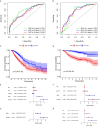Identification of a Ferroptosis-Related LncRNA Signature as a Novel Prognosis Model for Lung Adenocarcinoma
- PMID: 34249715
- PMCID: PMC8260838
- DOI: 10.3389/fonc.2021.675545
Identification of a Ferroptosis-Related LncRNA Signature as a Novel Prognosis Model for Lung Adenocarcinoma
Abstract
Lung adenocarcinoma (LUAD) is a highly heterogeneous malignancy, which makes prognosis prediction of LUAD very challenging. Ferroptosis is an iron-dependent cell death mechanism that is important in the survival of tumor cells. Long non-coding RNAs (lncRNAs) are considered to be key regulators of LUAD development and are involved in ferroptosis of tumor cells, and ferroptosis-related lncRNAs have gradually emerged as new targets for LUAD treatment and prognosis. It is essential to determine the prognostic value of ferroptosis-related lncRNAs in LUAD. In this study, we obtained RNA sequencing (RNA-seq) data and corresponding clinical information of LUAD patients from The Cancer Genome Atlas (TCGA) and Gene Expression Omnibus (GEO) database and ferroptosis-related lncRNAs by co-expression analysis. The best predictors associated with LUAD prognosis, including C5orf64, LINC01800, LINC00968, LINC01352, PGM5-AS1, LINC02097, DEPDC1-AS1, WWC2-AS2, SATB2-AS1, LINC00628, LINC01537, LMO7DN, were identified by Least Absolute Shrinkage and Selection Operator (LASSO) Cox regression analysis, and the LUAD risk prediction model was successfully constructed. Kaplan-Meier analysis, receiver operating characteristic (ROC) time curve analysis and univariate and multivariate Cox regression analysis and further demonstrated that the model has excellent robustness and predictive ability. Further, based on the risk prediction model, functional enrichment analysis revealed that 12 prognostic indicators involved a variety of cellular functions and signaling pathways, and the immune status was different in the high-risk and low-risk groups. In conclusion, a risk model of 12 ferroptosis related lncRNAs has important prognostic value for LUAD and may be ferroptosis-related therapeutic targets in the clinic.
Keywords: ferroptosis; lncRNAs; lung adenocarcinoma; prognosis; risk score.
Copyright © 2021 Lu, Liu, Zhao, Gui and Zhao.
Conflict of interest statement
The authors declare that the research was conducted in the absence of any commercial or financial relationships that could be construed as a potential conflict of interest.
Figures





References
LinkOut - more resources
Full Text Sources

